Reputation-Based Blockchain for Spatial Crowdsourcing in Vehicular Networks
Abstract
1. Introduction
1.1. Background
1.2. Related Work
1.3. Motivation and Contribution
- A blockchain-based crowdsourcing framework is proposed for vehicular networks. Without the presence of a third-party, the crowdsourcing framework is completed based on the supervision and operation of smart contracts, which can ensure user privacy and data security.
- An incentive scheme based on blockchain reputation is designed. Estimated from the historical behaviors and interactions, honest behavior is incentivized. In addition, comprehensive reputation and local reputation will encourage more vehicle miners to provide high-quality information for real-time crowdsourcing tasks.
- An honesty behavior reputation update algorithm is proposed to determine the general necessary conditions for pool miners and iteratively obtain the benefits. Subsequently, the proportion of high-reputation miners can be increased by the proposed low-reputation miner screening algorithm, which can improve the integrity level.
- Extensive simulations are conducted to verify and analyze the proposed reputation mechanism. The results show that the incentive method proposed in this paper can improve the efficiency and data reliability of the considered spatial crowdsourcing problem in Vehicular Networks.
1.4. Structure
2. System Model
2.1. System Architecture
2.2. Blockchain
2.3. Smart Contract
- URC. Once a miner or customer/requester joins the crowdsourcing platform, their individual information is first registered in URC. Note that when the requestor initiates service requests, the publishing of crowdsourcing tasks will be charged based on complexity (e.g., time delay, throughput, etc., see Section 4.2). In addition, miners in different blockchains are able to have multiple virtual addresses and corresponding public–private key pairs.
- UDC. The historical behaviors and interactions, individual configuration, and corresponding task information are stored by UDC. We propose to construct multiple indicators of reputation to evaluate blockchain players. Accordingly, reputation could be evaluated and updated in real-time within mining step-by-step, so as to reflect the reputation scoring. Once requesters submit the crowdsourcing information list, the creation of a corresponding pointer can help find the crowdsourcing information that they submitted through TRC.
- TRC. TRC mainly depicts the interaction between requesters and miners, including task publishing, miners’ actions, incentive/reputation evaluations. In accordance with the requesters, miners are first evaluated based on their reputation. To optimize mining strategy, qualified high-reputation miners will be allocated computational tasks according to the presented the low-reputation miner screening algorithm for mining pools under the limited budget (see in Section 4.3).
- MSC. Side chains are derived from the main chain which is a process driven by MSC. Being compatible with the smart contract from the main chain, the side chain is derived for functional scenarios, and the MSC is utilized to perform the conversion of cross-chain information (i.e., revenue and reputation). The assets of all chains are updated synchronously in real-time. Based on multiple virtual identities generated by URC, miners can allocate computing resources on multiple chains.
| Algorithm 1 Honesty behavior reputation update algorithm |
Input: The historical record, reputation entry threshold and the reputation fluctuation . Output: Reputation, historical record, rewards and optimal behaviors. Initialize , , Repeat while
for , and . Miner j can join the pool i to solve PoW puzzles. Calculates and to obtain . if Calculate according to (15). else Calculate according to (15). do until Calculate according to (16). Update the reputation . loop end if end for end while end |
| Algorithm 2 A low-reputation miner screening algorithm for mining pools |
Input: , , . Output: , , . Initialize , , . Repeat while
for , and . Miner j can join the pool i to solve PoW puzzles. Randomly adjust the screening threshold . Screen the pool miners of high-reputation. if Miner could be admitted joining in -th mining else Miner j would be expelled from the first screening. end if Calculate and compare to . do until . Subtract from by the -greedy policy. Update . loop end for end while end |
2.4. Analysis
3. Reputation-Based Honest Blockchain Pool Mining
3.1. Reputation Mechanism
3.2. Local Reputation
3.3. Comprehensive Reputation
3.4. Utility Function
- The reward is unrelated to the order of joining in the group. Honest pool miners contribute computational resources for mining and obtain reward based on their contributed proportion.
- The miners can only obtain rewards based on contributions. There are only two roles in the mining pool, pool managers and miners. Pool managers collect management fees based on the participation, and miners receive only dividends.
- The benefits of multiple tasks do not conflict with each other. Miners can choose to contribute part of computational resources to join multiple chains. The incentive and reputation between tasks can be individually accumulated, where the proof of cross-chain assets needs to be based on side-chain protocols.
- The strategy set of pool miners consists of honest or dishonest actions, but only honesty can be rewarded.
3.5. Reputation Estimation Based on Probability Interval
3.6. Incentive Decision-Making Based on Probability Interval
4. ReBLOM-Based Crowdsourcing for EVs Routing Problem with Recharging Station
4.1. Spatial Crowdsourcing
4.2. Crowdsourcing Task for Road Conditions
- Based on the Fuzzy Evaluation Theory [37], the factors (i.e., subjective, objective, interaction and objective factors) that determine the difficulty of the task can be effectively evaluated. First of all, by constructing a multi-level analysis structure model through the AHP method, the factor universe of the evaluation object can be determined; secondly, determine the comment level universe set, where a set of various total evaluation results in the evaluator creating the object to be evaluated; thirdly, establish the fuzzy relationship matrix and then determine the fuzzy weight vector of the evaluation factors, that is, assign the corresponding weights to each factor; finally, the fuzzy comprehensive evaluation model is obtained. Fuzzy evaluation deals with the fuzzy evaluation objects by precise digital means, and can make a scientific, reasonable and realistic quantitative evaluation for the data that contains the ambiguity.
- Entropy Value Method [38]. According to the definition of information entropy, for a special index (e.g., ), we can use the entropy value to judge the degree of dispersion of an index: a smaller entropy value will lead to a greater degree of dispersion of the index, and a greater impact (i.e., weight) of the index on the comprehensive evaluation [39]. The scheme is as follows: first, the index system for evaluation needs to be determined; then, the maximum/minimum values in each index are eliminated to reduce the influence of extreme value data on the entropy; thirdly, the critical value method or Z-score method can help quantify each index, that is, converts the actual value of the index into an index evaluation value that is not affected by the dimension; finally, calculates the index entropy and weight, and obtains the index weighted calculation score. The main advantage of this method lies in the construction of a two-level evaluation system: the upper layer may need to be constructed in combination with experience, while the indicators at the bottom are more detailed and the weights are more difficult to determine.
4.3. Distance-Based ReBLOM Crowdsourcing
4.4. Distance-Based Spatial Reputation for EVs Charging
4.5. Potential Threats
- “Sybil” attack: In distributed vehicle-to-vehicle communication systems, malicious attackers can claim or register different identities to disrupt normal functioning. In the vehicular environment, selfish nodes with multiple identities and malicious intent can control other vehicles/nodes at a given moment, thereby disrupting the system performance. Considering the dynamic and fast-moving nature of the vehicular networks, such attacks are easily launched by attackers, so as to cause substantial damage to the system [41]. The blockchain has the characteristics of distributed ledgering and can utilize asymmetric encryption theory to ensure the security of information interaction/communication between blockchain nodes, e.g., ECC. Secondly, URC (see in Section 2.3) can ensure the confirmation of user identity at all stages of communication, such as the corresponding key, unreproducible digital signature and unique ID, etc. Thereby users participating in blockchain cannot be forged and duplicated. Further, based on the main-side chain mechanism established by TRC and MSC, it can realize real-time synchronization of comprehensive reputation across chains and assets, where is under the premise of correct identity verification. Finally, a trusted certificate authority based on smart contracts inside the block can also verify the identity of communicating entities to prevent “Sybil” attacks.
- Denial of Service attack: In this kind of attack [7], malicious nodes can disrupt vehicle-to-vehicle communications by sending fake customer requests. That is, the attacker bombards the real server/host node with requests, so that the blockchain system perform excessive and useless calculations, rendering it unable to serve real requests. Hence, it may result in the consumption of computational resources and interruption of the normal service. As a result, EVs will not be able to obtain the required data, e.g., road conditions, and the stability of vehicular networks can even be undermined. In our scheme, when customers generate service requests, they will first submit their task requirements and publish to blockchain network. Once the validity of crowdsourcing tasks can be verified, the customer can release the tasks in the form of transactions after being paid (i.e., part of the incentive). Based on customer payment acting as a pledge, validity verification as a means, and penalty function (see in Section 4.3) as a defensive measure, it can verify customer identity and requests, thereby protecting the system from Denial of Service attack. It should be added that for miners, the historical honesty/dishonesty behaviors in each mining rounds will be recorded in the ledger, which is obviously bound to the unique ID. For the mining pool, a miner joins in by contributing computational resources, and the survival time indicator will serve as the most direct index to determine the historical honest behavior of miners.
- Man in the Middle (MITM) attack: Malicious vehicle nodes mislead real vehicles in the vehicular networks by modifying routing information. MITM [30] establishes contact with senders and receivers, respectively, from which malicious entities obtain confidential information (i.e., keys or data), and falsify information. MITM is a critical attacker as all the vehicles can be spoofed as though the information came from real nodes. The attacker accesses the vehicular system and the sent packets, modifies the real transactions, and sends them to the sink nodes. In the formulated blockchain-based reputation system, the information exchange between vehicle nodes is realized through unique paired public/private keys. The data packets transmitted by the channel are all encrypted, and excluding the corresponding key, cannot be read. Due to the characteristics of the blockchain-distributed ledger, information/data cannot be forged or tampered with unless it reaches of the system’s computing power. Likewise, a decentralized network structure can minimize this kind of attack.
- Malicious Trust Center attack [30]: Malicious nodes act as relay nodes and are also responsible for forwarding information/packs, but in the wrong direction. That is, malicious nodes masquerade as vehicle relay nodes that maintain a high reputation value and honest historical behavior. Similar to a black hole attack, the masquerading relay node sends a packet to a malicious node, where it is then dropped. In the traditional centralized reputation mechanism, the reputation values of vehicle miners are stored in a centralized trust center. Therefore, a malicious trust center may obtain benefits by tampering with or forging the reputation value of vehicle participants. In our proposed system, transactions are stored on the blockchain, and not on a trusted center. This ensures that the reputation value will not be tampered with by malicious nodes, and solves the potential threat brought about by malicious trust centers. Moreover, the calculation of local reputation and comprehensive reputation depends on subjective and objective reputation evaluation and cross-chain historical reputation. The information recorded in the previous block is difficult to forge or tamper with through disguise or attack.
5. Performance Evaluation
5.1. Experiment Specification
5.2. Performance of the Reputation-Based Incentive Mechanism
5.3. Performance Based on Spatial Crowdsourcing Reputation
5.4. Algorithm Performance
6. Conclusions
Author Contributions
Funding
Institutional Review Board Statement
Informed Consent Statement
Data Availability Statement
Conflicts of Interest
References
- Liu, R.; Wang, J.; Zhang, B. High Definition Map for Automated Driving: Overview and Analysis. J. Navig. 2020, 73, 324–341. [Google Scholar] [CrossRef]
- Galvagno, A.; Previti, U.; Famoso, F.; Brusca, S. An Innovative Methodology to Take into Account Traffic Information on Wltp Cycle for Hybrid Vehicles. Energies 2021, 14, 1548. [Google Scholar] [CrossRef]
- Okwuibe, G.C.; Li, Z.; Brenner, T.; Langniss, O. A Blockchain Based Electric Vehicle Smart Charging System with Flexibility. IFAC-PapersOnLine 2020, 53, 13557–13561. [Google Scholar] [CrossRef]
- Zhu, S.; Cai, Z.; Hu, H.; Li, Y.; Li, W. Zkcrowd: A Hybrid Blockchain-Based Crowdsourcing Platform. IEEE Trans. Industr Inform. 2020, 16, 4196–4205. [Google Scholar] [CrossRef]
- Das, H.S.; Rahman, M.M.; Li, S.; Tan, C.W. Electric Vehicles Standards, Charging Infrastructure, and Impact on Grid Integration: A Technological Review. Renew. Sust. Energ. Rev. 2020, 120, 109618. [Google Scholar] [CrossRef]
- He, Y.; Zhang, C.; Wu, B.; Geng, Z.; Xiao, K.; Li, H. A Trusted Architecture for Ev Shared Charging Based on Blockchain Technology. High-Confid. Comput. 2021, 1, 100001. [Google Scholar] [CrossRef]
- Yang, Z.; Yang, K.; Lei, L.; Zheng, K.; Leung, V.C.M. Blockchain-Based Decentralized Trust Management in Vehicular Networks. IEEE Internet Things J. 2019, 6, 1495–1505. [Google Scholar] [CrossRef]
- Wang, X.; Garg, S.; Lin, H.; Kaddoum, G.; Hu, J.; Hassan, M.M. Heterogeneous Blockchain and Ai-Driven Hierarchical Trust Evaluation for 5g-Enabled Intelligent Transportation Systems. IEEE Trans. Intell. Transp. Syst. 2021, 1–10. [Google Scholar] [CrossRef]
- Babel, M.; Gramlich, V.; Körner, M.-F.; Sedlmeir, J.; Strüker, J.; Zwede, T. Enabling End-to-End Digital Carbon Emission Tracing with Shielded Nfts. Energy Inform. 2022, 5, S1. [Google Scholar] [CrossRef]
- Alsamhi, S.H.; Shvetsov, A.V.; Kumar, S.; Hassan, J.; Alhartomi, M.A.; Shvetsova, S.V.; Sahal, R.; Hawbani, A. Computing in the Sky: A Survey on Intelligent Ubiquitous Computing for Uav-Assisted 6g Networks and Industry 4.0/5.0. Drones 2022, 6, 177. [Google Scholar] [CrossRef]
- Gao, L.; Li, L.; Chen, Y.; Xu, C.; Xu, M. Fgfl: A Blockchain-Based Fair Incentive Governor for Federated Learning. J. Parallel Distrib. Comput. 2022, 163, 283–299. [Google Scholar] [CrossRef]
- Alsamhi, S.H.; Shvetsov, A.V.; Shvetsova, S.V.; Hawbani, A.; Guizan, M.; Alhartomi, M.A.; Ma, O. Blockchain-Empowered Security and Energy Efficiency of Drone Swarm Consensus for Environment Exploration. IEEE Trans. Green Commun. Netw. 2022, 1. [Google Scholar] [CrossRef]
- Chiacchio, F.; D’Urso, D.; Oliveri, L.M.; Spitaleri, A.; Spampinato, C.; Giordano, D. A Non-Fungible Token Solution for the Track and Trace of Pharmaceutical Supply Chain. Appl. Sci. 2022, 12, 4019. [Google Scholar] [CrossRef]
- Li, M.; Weng, J.; Yang, A.; Lu, W.; Zhang, Y.; Hou, L.; Liu, J.N.; Xiang, Y.; Deng, R.H. Crowdbc: A Blockchain-Based Decentralized Framework for Crowdsourcing. IEEE Trans. Parallel Distrib. Syst. 2019, 30, 1251–1266. [Google Scholar] [CrossRef]
- Wu, H.; Düdder, B.; Wang, L.; Sun, S.; Xue, G. Blockchain-Based Reliable and Privacy-Aware Crowdsourcing with Truth and Fairness Assurance. IEEE Internet Things J. 2022, 9, 3586–3598. [Google Scholar] [CrossRef]
- Lin, C.; He, D.; Zeadally, S.; Kumar, N.; Choo, K.-K.R. Secbcs: A Secure and Privacy-Preserving Blockchain-Based Crowdsourcing System. Sci. China Inf. Sci. 2020, 63, 130102. [Google Scholar] [CrossRef]
- Yang, H.; Wang, G.; Zhai, Z.; He, X. Towards Decentralized Trust Management Using Blockchain in Crowdsourcing Networks. In Proceedings of the 2020 International Conference on Cyber-Enabled Distributed Computing and Knowledge Discovery (CyberC), Chongqing, China, 29–30 October 2020. [Google Scholar] [CrossRef]
- Tan, L.; Xiao, H.; Shang, X.; Wang, Y.; Ding, F.; Li, W. A Blockchain-Based Trusted Service Mechanism for Crowdsourcing System. In Proceedings of the 2020 IEEE 91st Vehicular Technology Conference (VTC2020-Spring), Antwerp, Belgium, 25–28 May 2020. [Google Scholar] [CrossRef]
- Kang, J.; Xiong, Z.; Niyato, D.; Xie, S.; Zhang, J. Incentive Mechanism for Reliable Federated Learning: A Joint Optimization Approach to Combining Reputation and Contract Theory. IEEE Internet Things J. 2019, 6, 10700–10714. [Google Scholar] [CrossRef]
- Asheralieva, A.; Niyato, D. Reputation-Based Coalition Formation for Secure Self-Organized and Scalable Sharding in Iot Blockchains with Mobile-Edge Computing. IEEE Internet Things J. 2020, 7, 11830–11850. [Google Scholar] [CrossRef]
- Wang, E.K.; Liang, Z.; Chen, C.-M.; Kumari, S.; Khan, M.K. Porx: A Reputation Incentive Scheme for Blockchain Consensus of Iiot. Future Gener. Comput. Syst. 2020, 102, 140–151. [Google Scholar] [CrossRef]
- Rehman, M.H.u.; Salah, K.; Damiani, E.; Svetinovic, D. Towards Blockchain-Based Reputation-Aware Federated Learning. In Proceedings of the IEEE INFOCOM 2020—IEEE Conference on Computer Communications Workshops (INFOCOM WKSHPS), Toronto, ON, Canada, 6–9 July 2020. [Google Scholar] [CrossRef]
- Gruhler, A.; Rodrigues, B.; Stiller, B. A Reputation Scheme for a Blockchain-Based Network Cooperative Defense. In Proceedings of the 2019 IFIP/IEEE Symposium on Integrated Network and Service Management (IM), Arlington, VA, USA, 8–12 April 2019. [Google Scholar]
- Tang, C.; Wu, L.; Wen, G.; Zheng, Z. Incentivizing Honest Mining in Blockchain Networks: A Reputation Approach. IEEE Trans. Circuits Syst. II Express Briefs. 2020, 67, 117–121. [Google Scholar] [CrossRef]
- Kang, J.; Xiong, Z.; Niyato, D.; Ye, D.; Kim, D.I.; Zhao, J. Toward Secure Blockchain-Enabled Internet of Vehicles: Optimizing Consensus Management Using Reputation and Contract Theory. IEEE Trans. Veh. 2019, 68, 2906–2920. [Google Scholar] [CrossRef]
- Alsamhi, S.H.; Almalki, F.A.; Afghah, F.; Hawbani, A.; Shvetsov, A.V.; Lee, B.; Song, H. Drones’ Edge Intelligence over Smart Environments in B5g: Blockchain and Federated Learning Synergy. IEEE Trans. Green Commun. Netw. 2022, 6, 295–312. [Google Scholar] [CrossRef]
- Liang, X.; Yan, Z.; Kantola, R. Gaimmo: A Grade-Driven Auction-Based Incentive Mechanism with Multiple Objectives for Crowdsourcing Managed by Blockchain. IEEE Internet Things J. 2022, 9, 17488–17502. [Google Scholar] [CrossRef]
- Alsamhi, S.H.; Almalki, F.A.; Al-Dois, H.; Shvetsov, A.V.; Ansari, M.S.; Hawbani, A.; Gupta, S.K.; Lee, B. Multi-Drone Edge Intelligence and SAR Smart Wearable Devices for Emergency Communication. Wirel Commun. Mob. Comput. 2021, 2021, 6710074. [Google Scholar] [CrossRef]
- Liu, W.; Wu, H.; Meng, T.; Wang, R.; Wang, Y.; Xu, C.-Z. Aucswap: A Vickrey Auction Modeled Decentralized Cross-Blockchain Asset Transfer Protocol. J. Syst. Architect. 2021, 117, 102102. [Google Scholar] [CrossRef]
- Wang, Y.; Su, Z.; Zhang, N. BSIS: Blockchain-Based Secure Incentive Scheme for Energy Delivery in Vehicular Energy Network. IEEE Trans. Industr Inform. 2019, 15, 3620–3631. [Google Scholar] [CrossRef]
- ElSalamouny, E.; Sassone, V. An Hmm-Based Reputation Model. In Proceedings of the Advances in Security of Information and Communication Networks, Cairo, Egypt, 3–5 September 2013. [Google Scholar]
- Malik, N.; Wei, Y.M.; Appel, G.; Luo, L. Blockchain Technology for Creative Industries: Current State and Research Opportunities. Int. J. Res. Mark. 2022; in press. [Google Scholar] [CrossRef]
- Camilo, G.F.; Rebello, G.A.F.; Souza, L.A.C.d.; Duarte, O.C.M.B. A Secure Personal-Data Trading System Based on Blockchain, Trust, and Reputation. In Proceedings of the 2020 IEEE International Conference on Blockchain (Blockchain), Rhodes, Greece, 2–6 November 2020. [Google Scholar] [CrossRef]
- Oren, N.; Norman, T.J.; Preece, A. Subjective Logic and Arguing with Evidence. Artif. Intell. 2007, 171, 838–854. [Google Scholar] [CrossRef]
- Shen, M.; Duan, J.; Zhu, L.; Zhang, J.; Du, X.; Guizani, M. Blockchain-Based Incentives for Secure and Collaborative Data Sharing in Multiple Clouds. IEEE J. Sel. Areas Commun. 2020, 38, 1229–1241. [Google Scholar] [CrossRef]
- Guo, W.; Chang, Z.; Guo, X.; Wu, P.; Han, Z. Incentive Mechanism for Edge Computing-Based Blockchain: A Sequential Game Approach. IEEE Trans. Industr. Inform. 2022, 18, 7899–7909. [Google Scholar] [CrossRef]
- Sharifi, M.; Manaf, A.A.; Memariani, A.; Movahednejad, H.; Dastjerdi, A.V. Consensus-Based Service Selection Using Crowdsourcing under Fuzzy Preferences of Users. In Proceedings of the 2014 IEEE International Conference on Services Computing, Anchorage, AK, USA, 27 June–2 July 2014. [Google Scholar] [CrossRef]
- Houda, Z.A.E.; Hafid, A.S.; Khoukhi, L. Cochain-Sc: An Intra- and Inter-Domain Ddos Mitigation Scheme Based on Blockchain Using Sdn and Smart Contract. IEEE Access. 2019, 7, 98893–98907. [Google Scholar] [CrossRef]
- Xia, D.; Xu, J.; Liu, W.; Zhao, X.; Zhang, R.; Li, Y.; Su, S. Ev Charging Guidance Strategy Considering Dynamic Road Network and Personalized Driving Conditions. In Proceedings of the 2019 IEEE 3rd International Electrical and Energy Conference (CIEEC), Beijing, China, 7–9 September 2019. [Google Scholar] [CrossRef]
- Kumar, S.; Velliangiri, S.; Karthikeyan, P.; Kumari, S.; Kumar, S.; Khan, M.K. A Survey on the Blockchain Techniques for the Internet of Vehicles Security. Trans. Emerging Telecommun. Tech. 2021, e4317. [Google Scholar] [CrossRef]
- Zhang, K.; Liang, X.; Lu, R.; Shen, X. Sybil Attacks and Their Defenses in the Internet of Things. IEEE Internet Things J. 2014, 1, 372–383. [Google Scholar] [CrossRef]
- Yuen, M.C.; Lau, K.M.; Ng, K.F. An Automated Solution for Improving the Efficiency of Cryptocurrency Mining. In Proceedings of the 2020 International Conference on COMmunication Systems & NETworkS (COMSNETS), Bengaluru, India, 7–11 January 2020. [Google Scholar] [CrossRef]
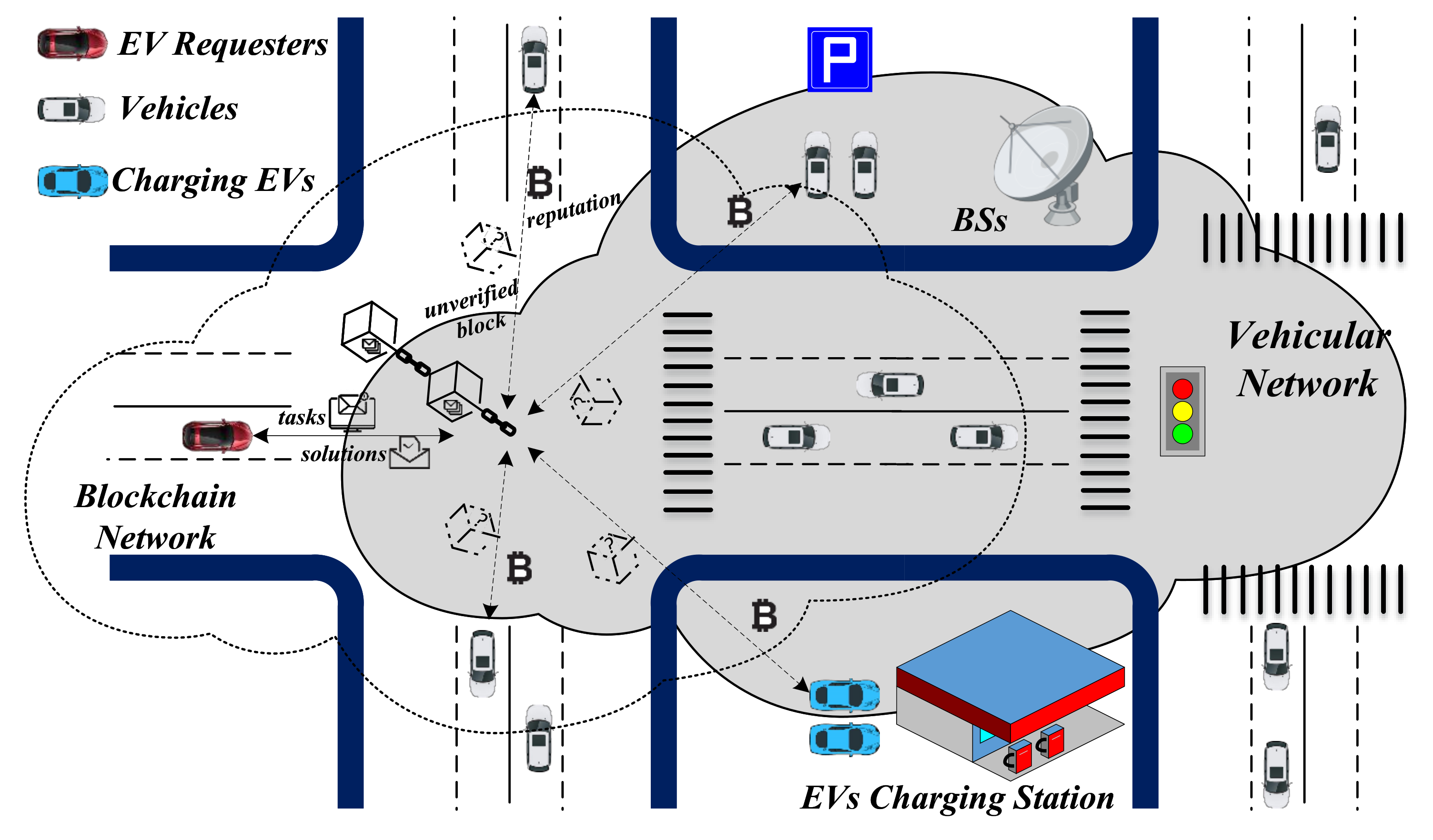

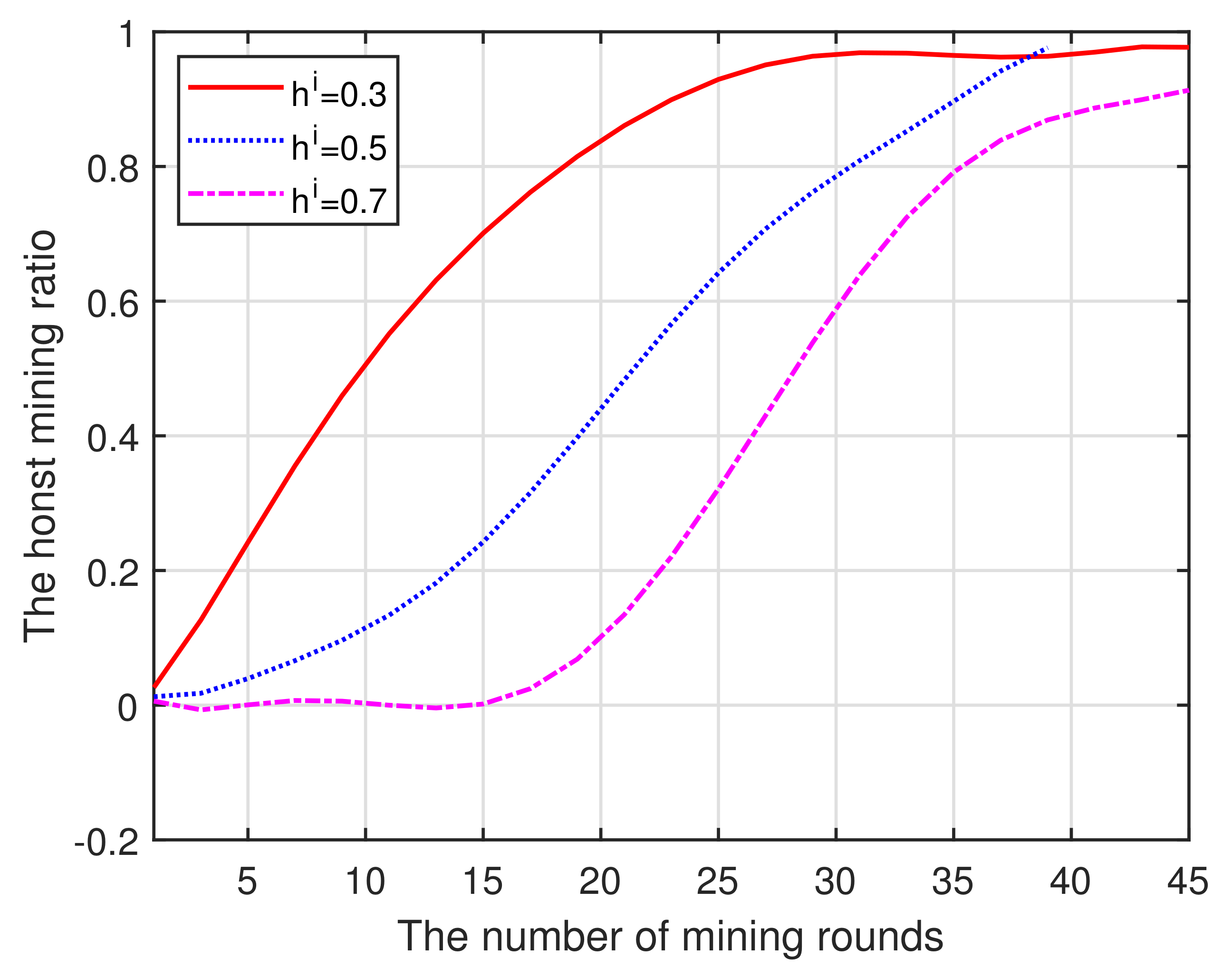
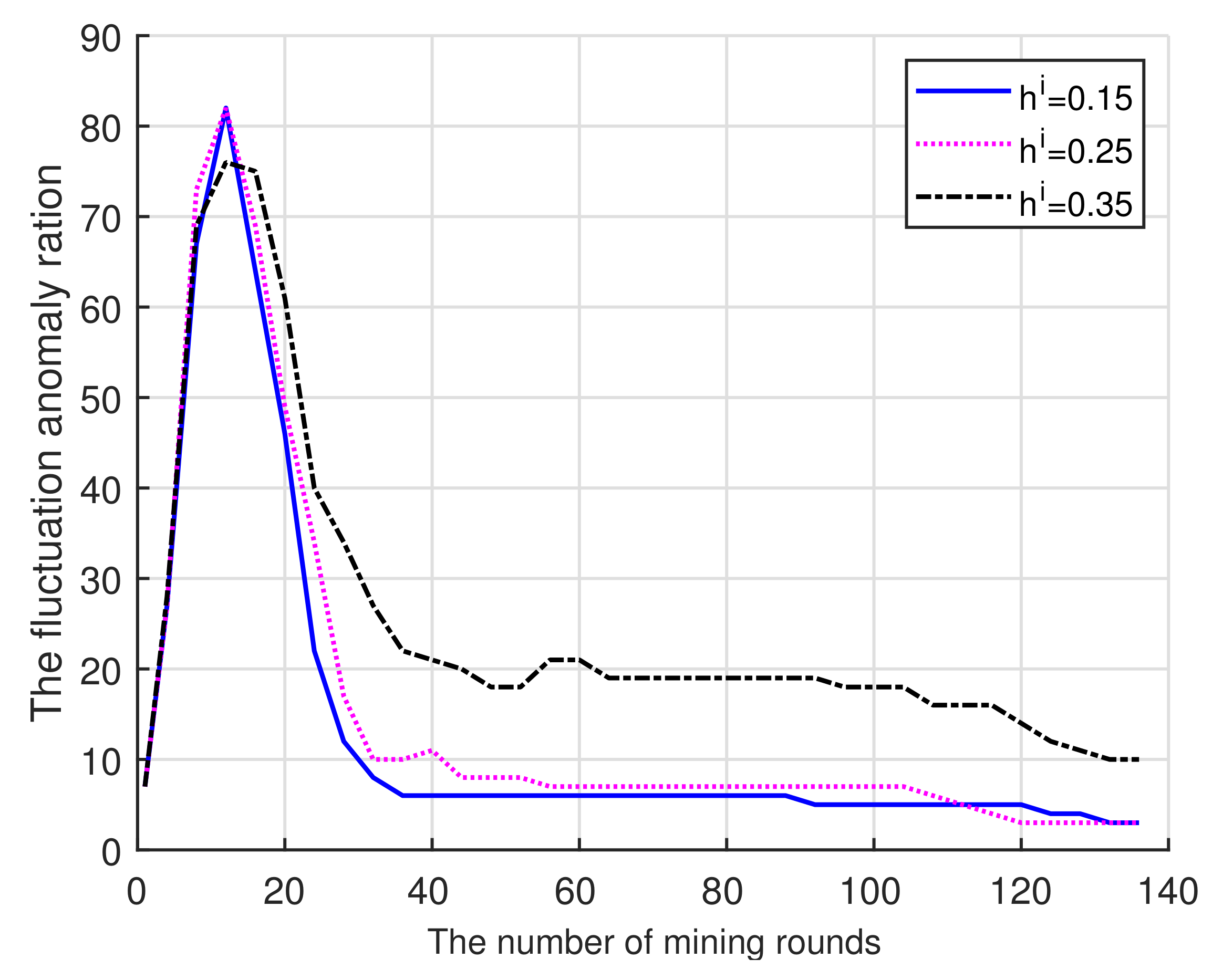
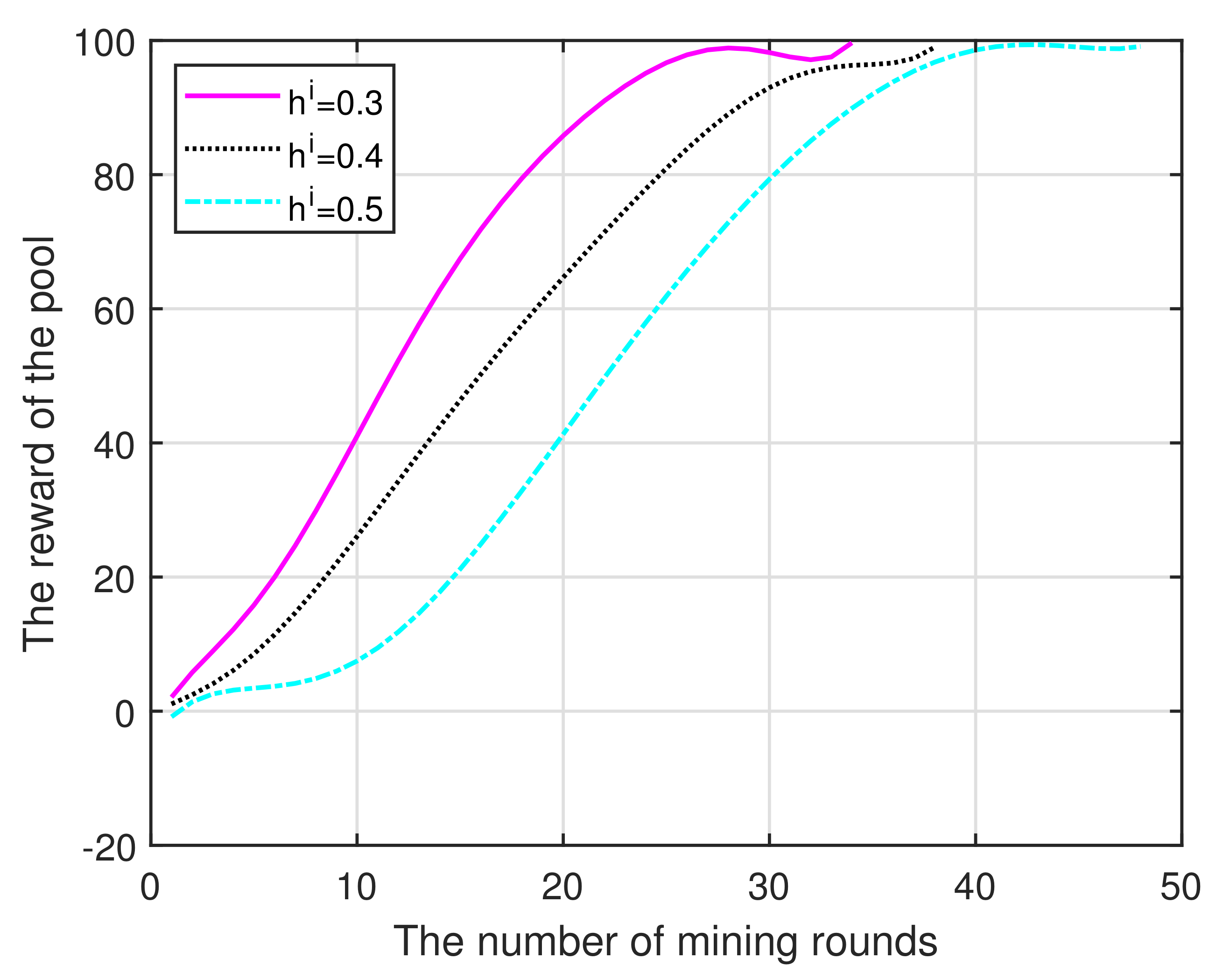
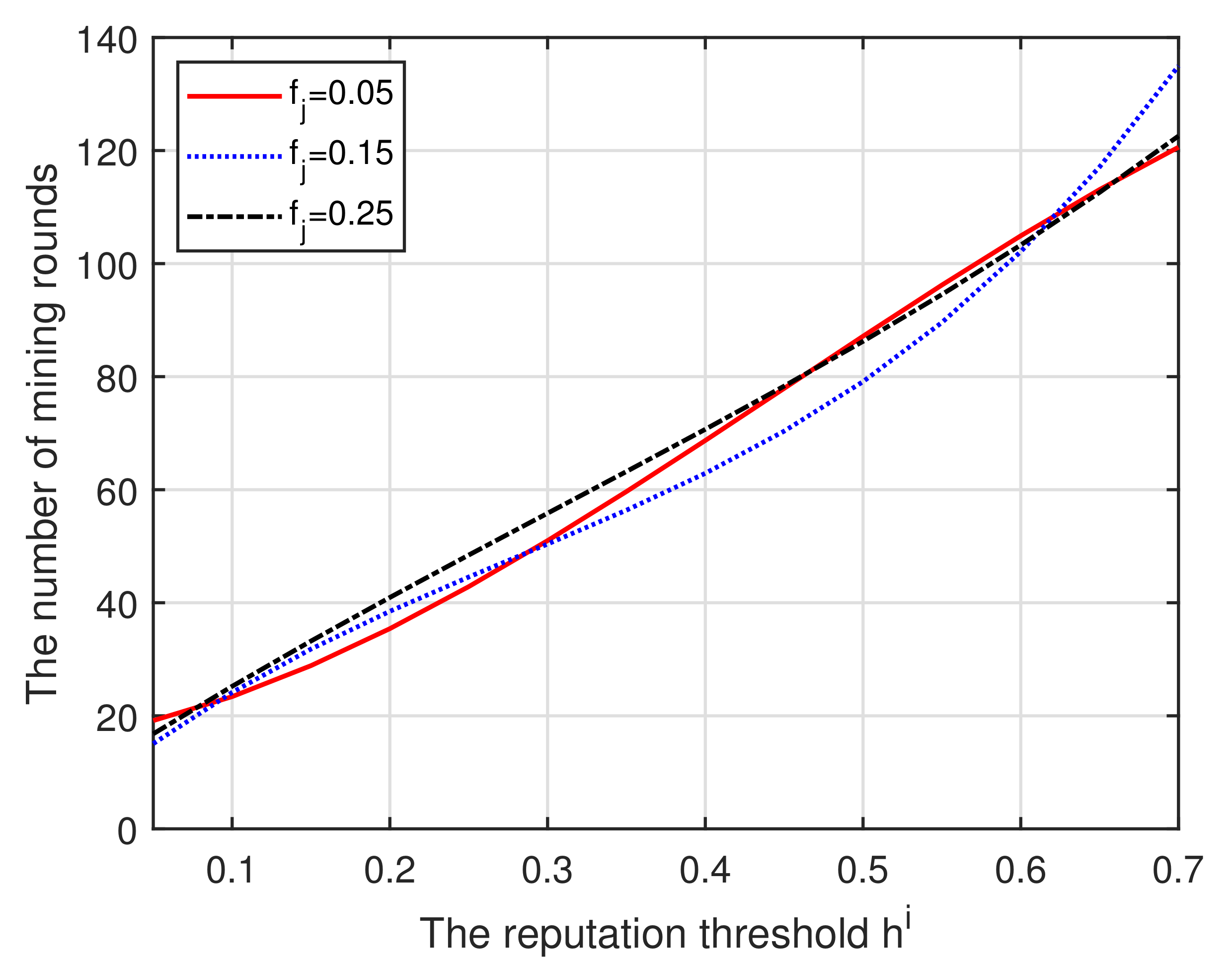
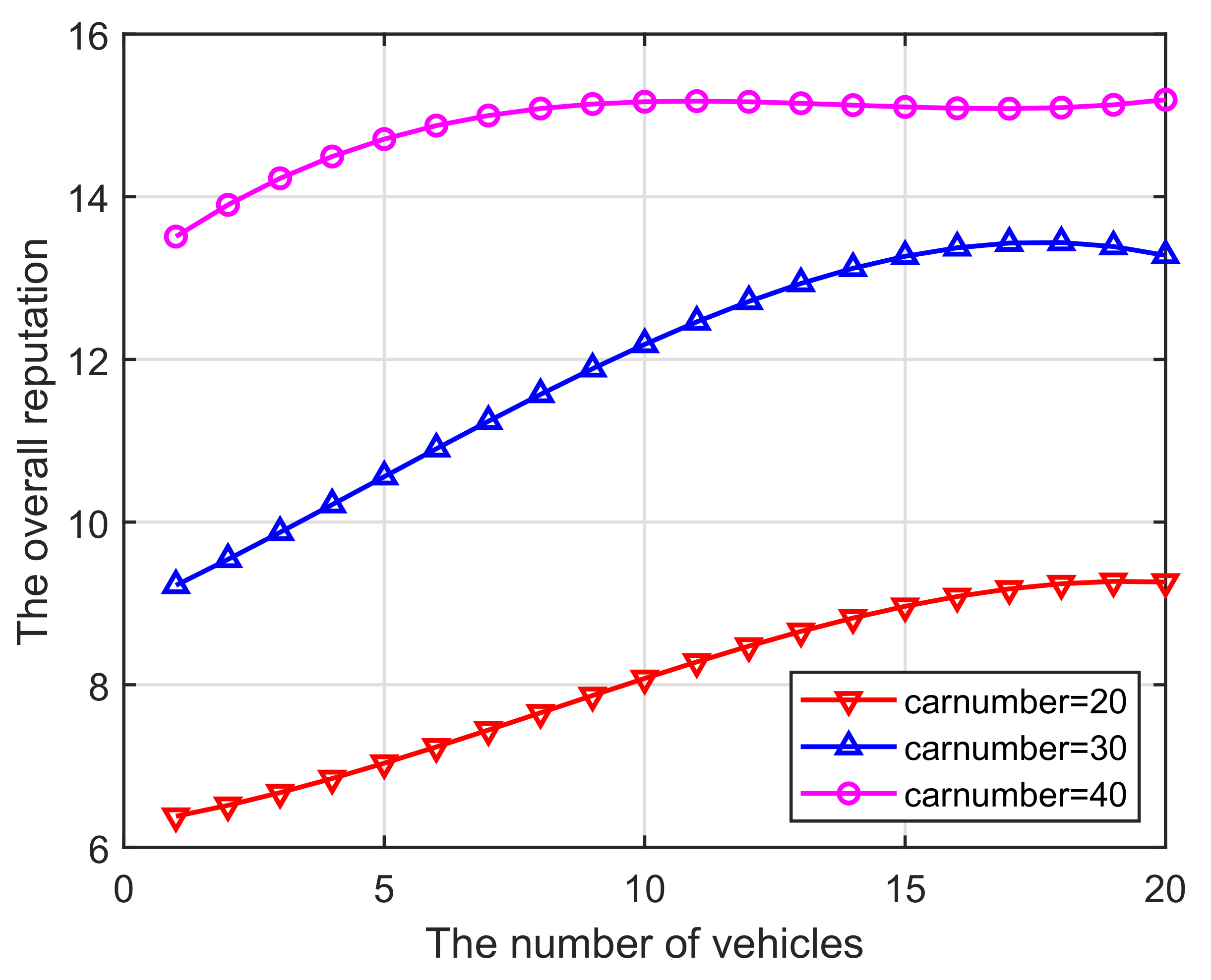
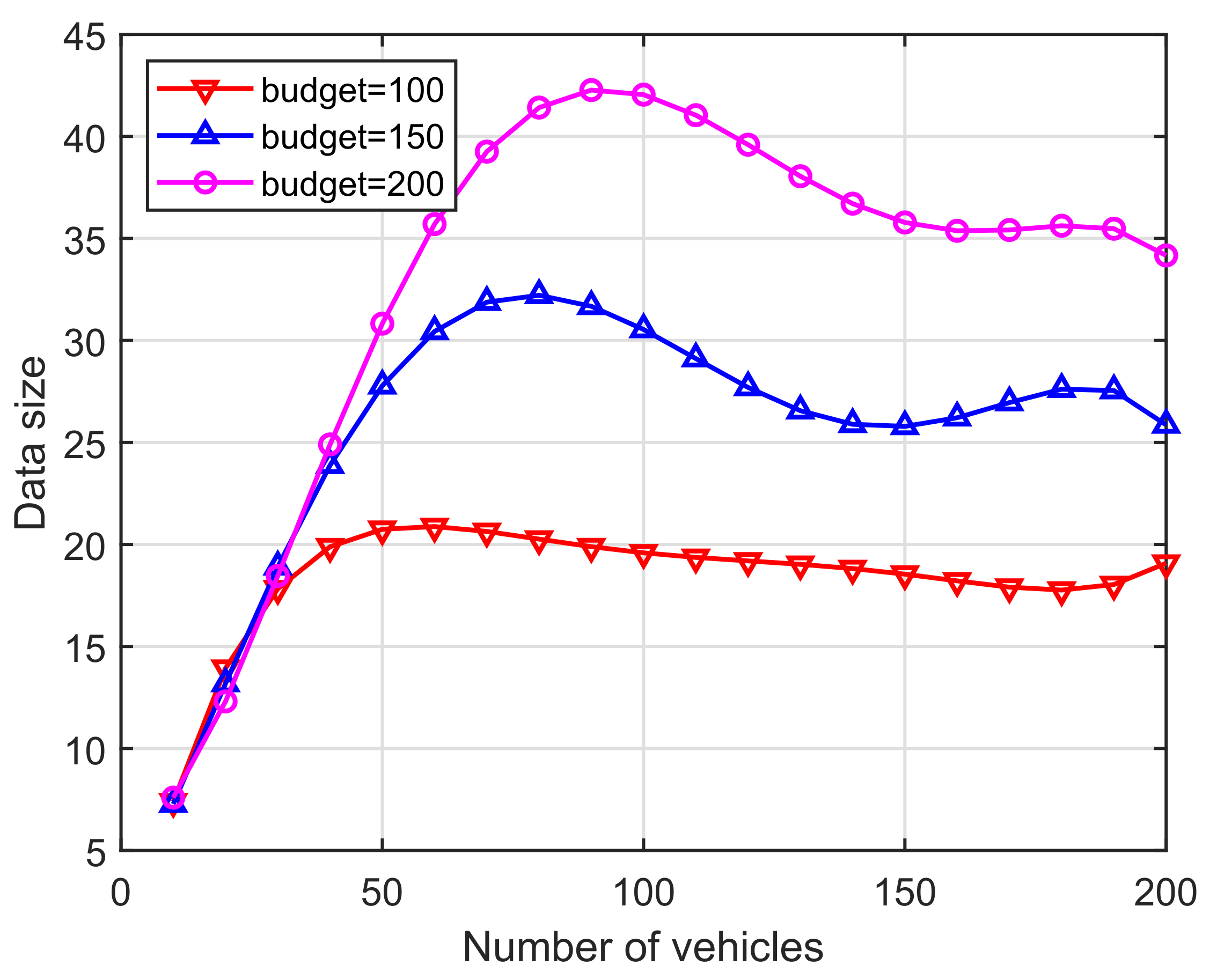
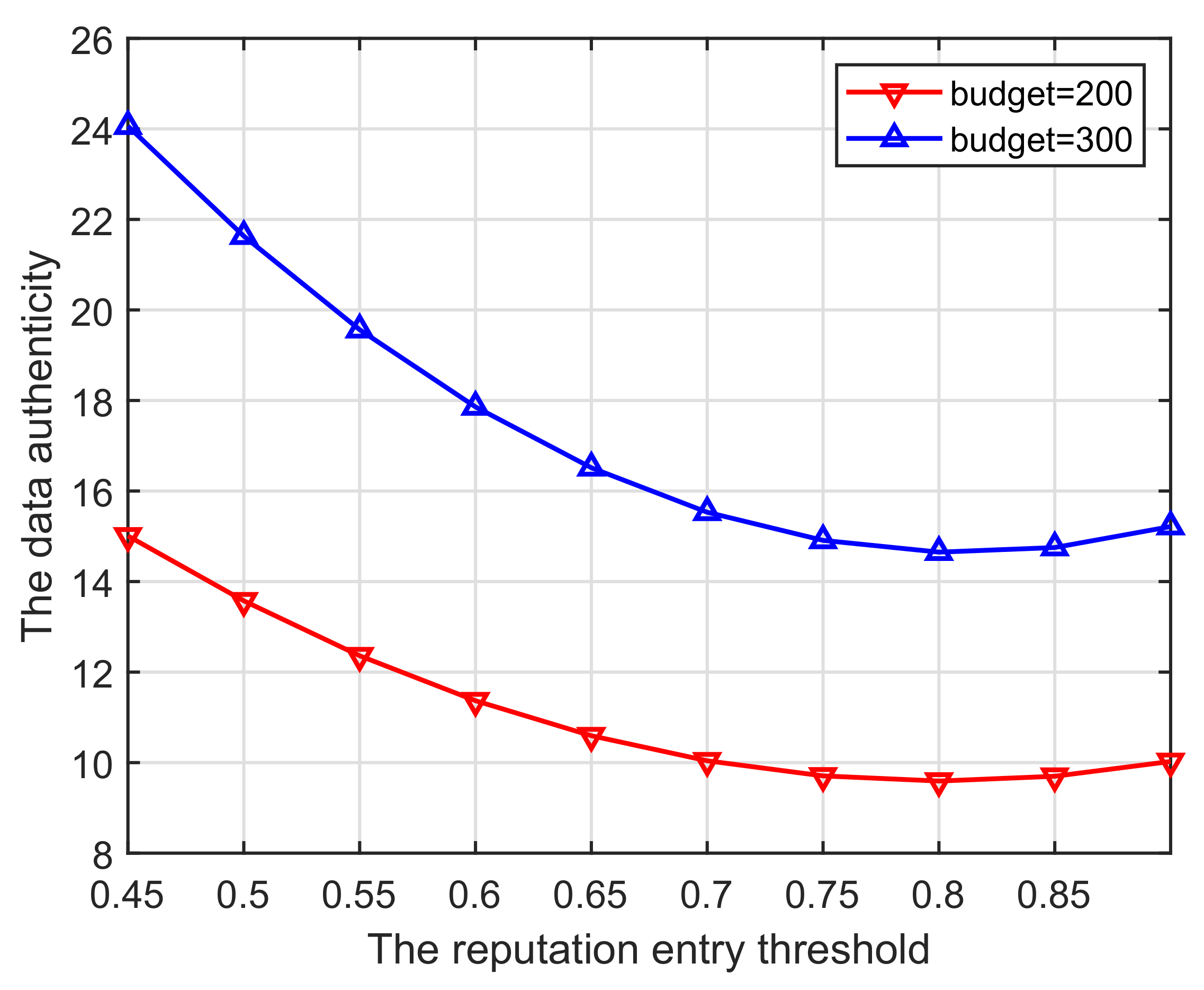
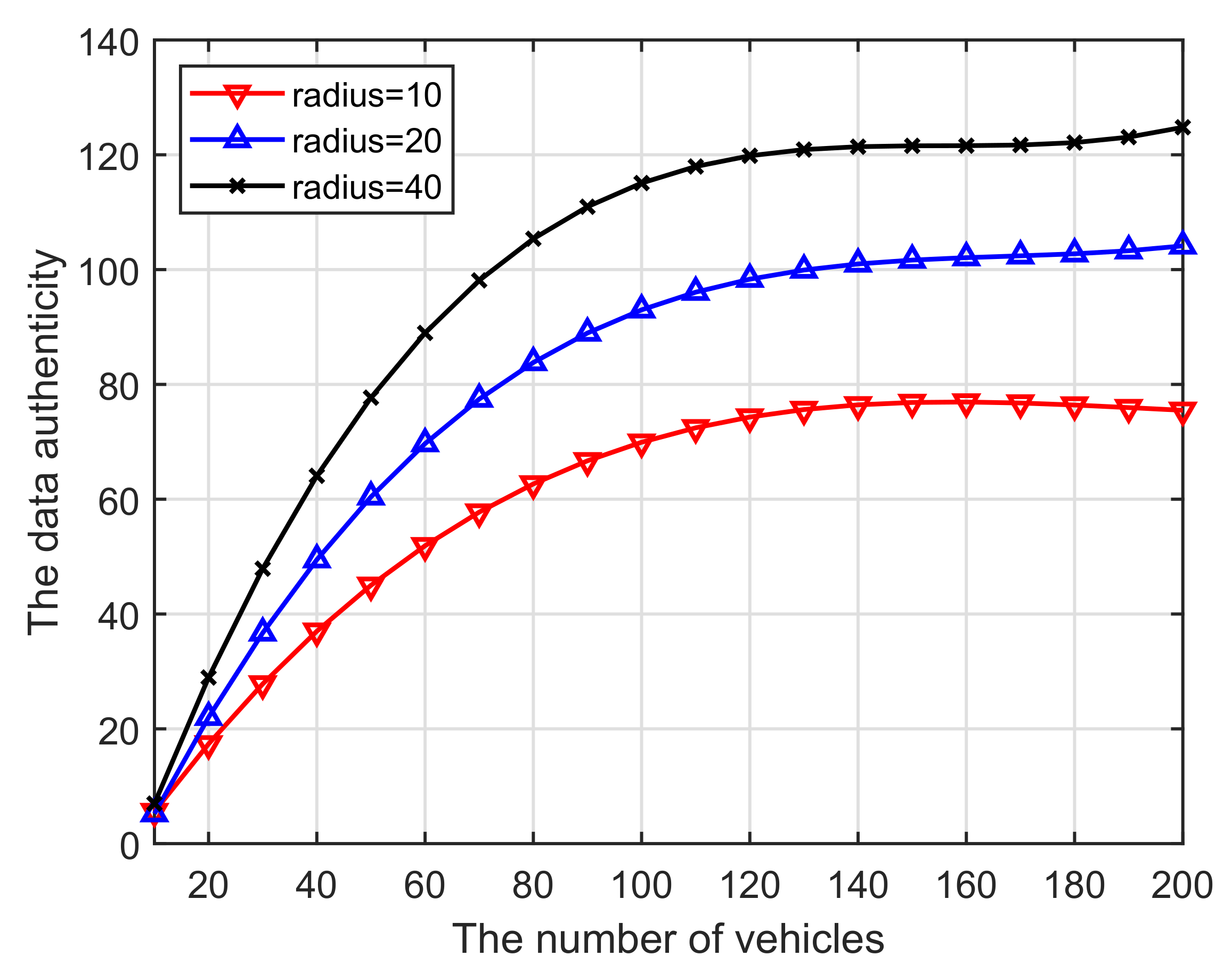
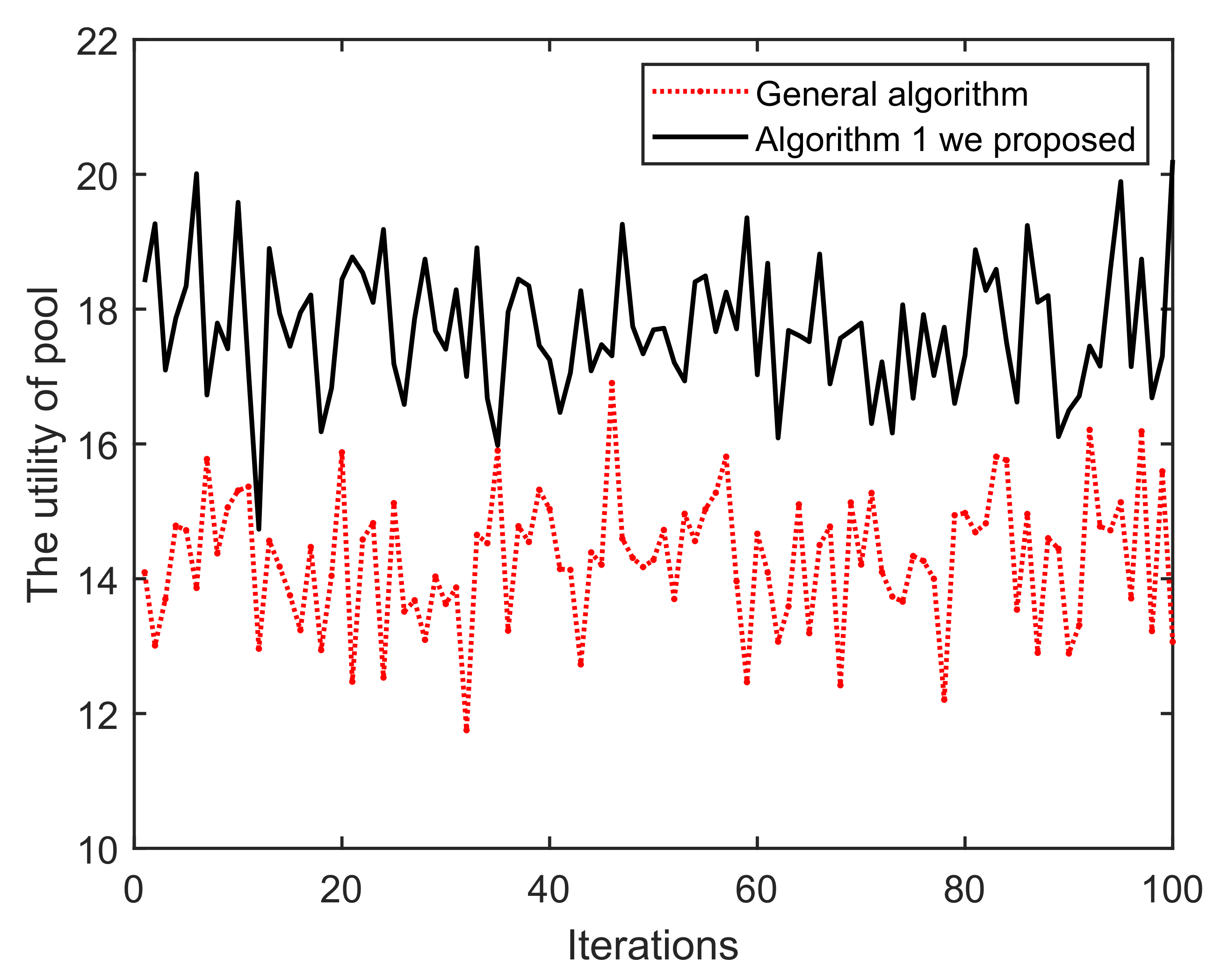
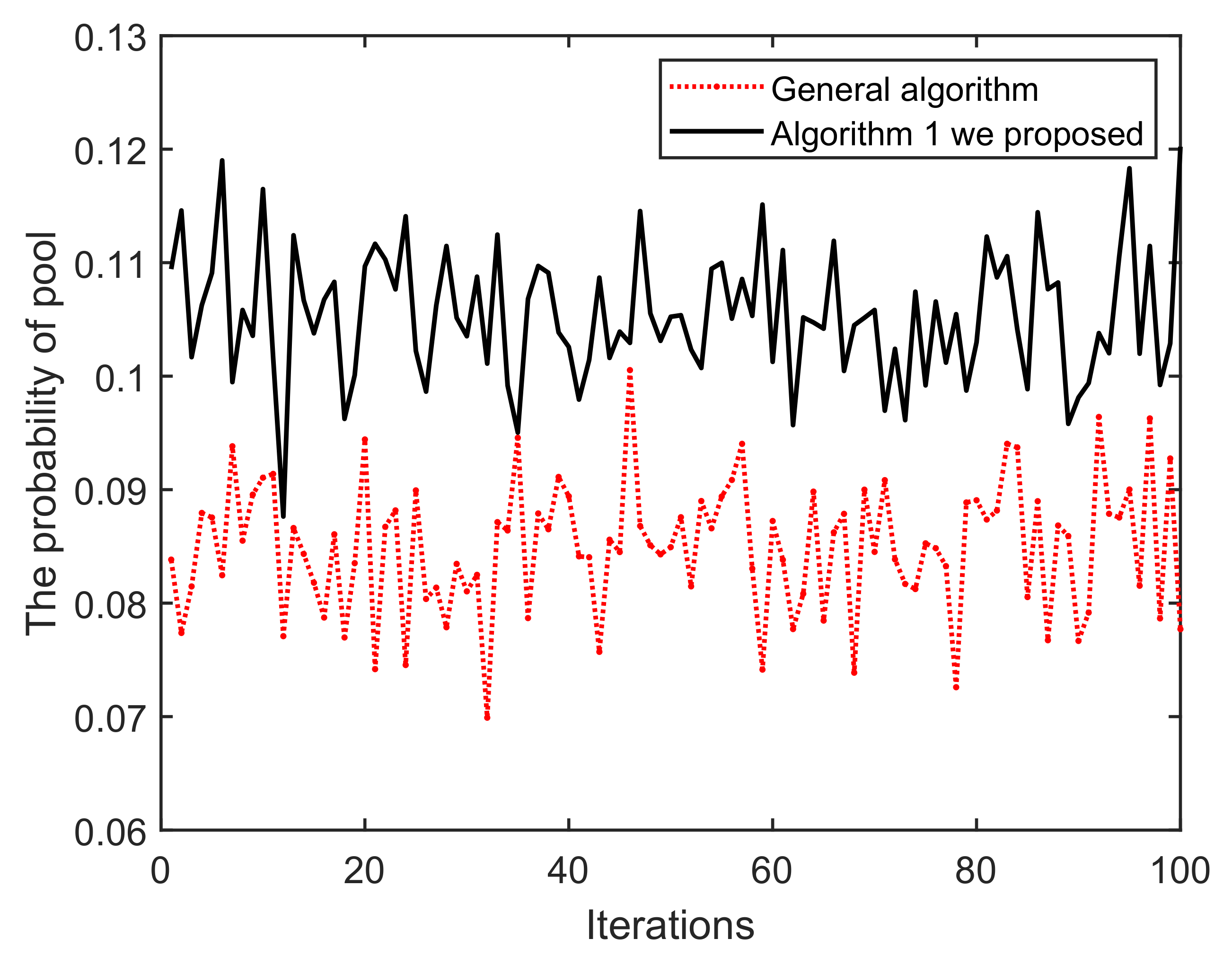
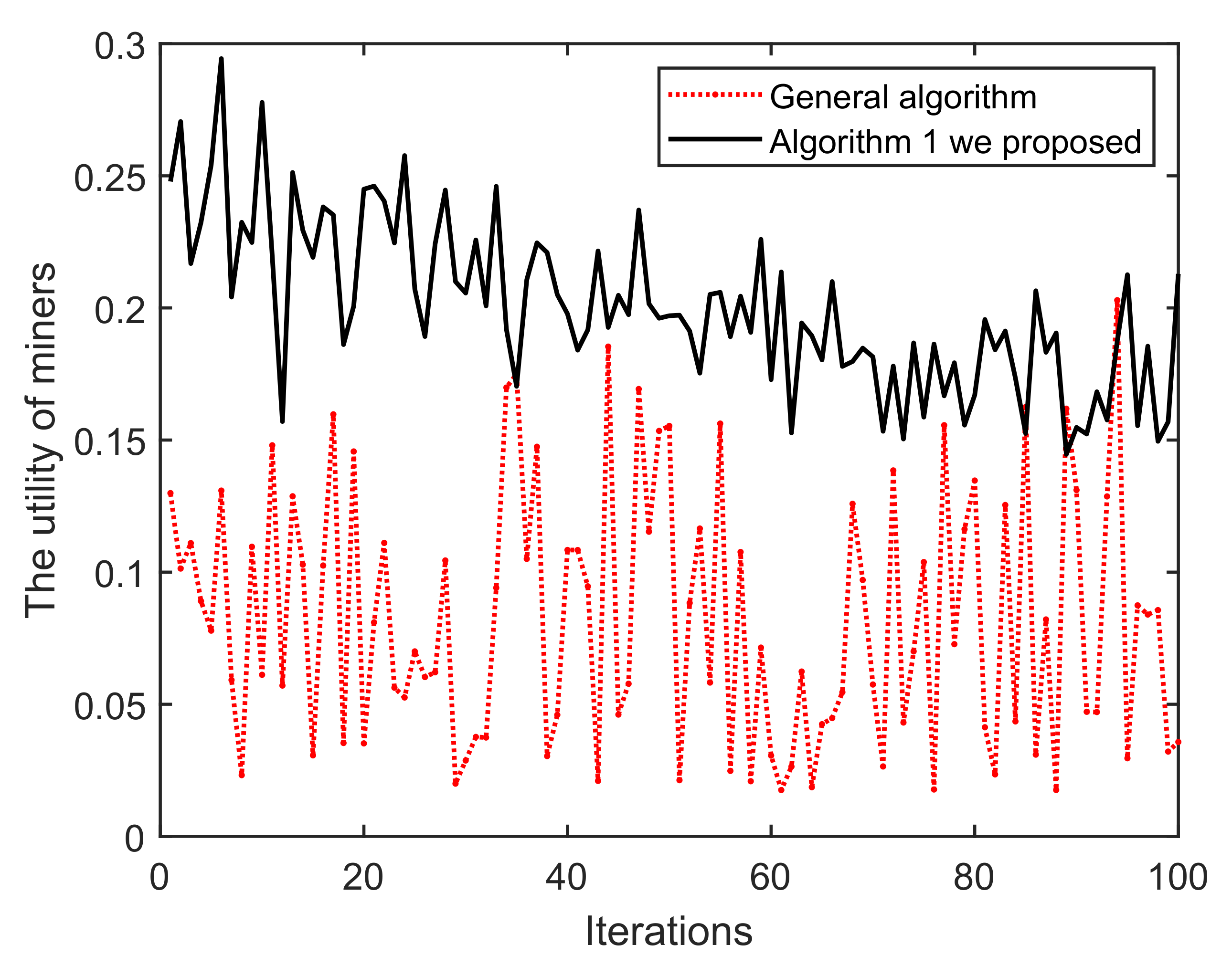
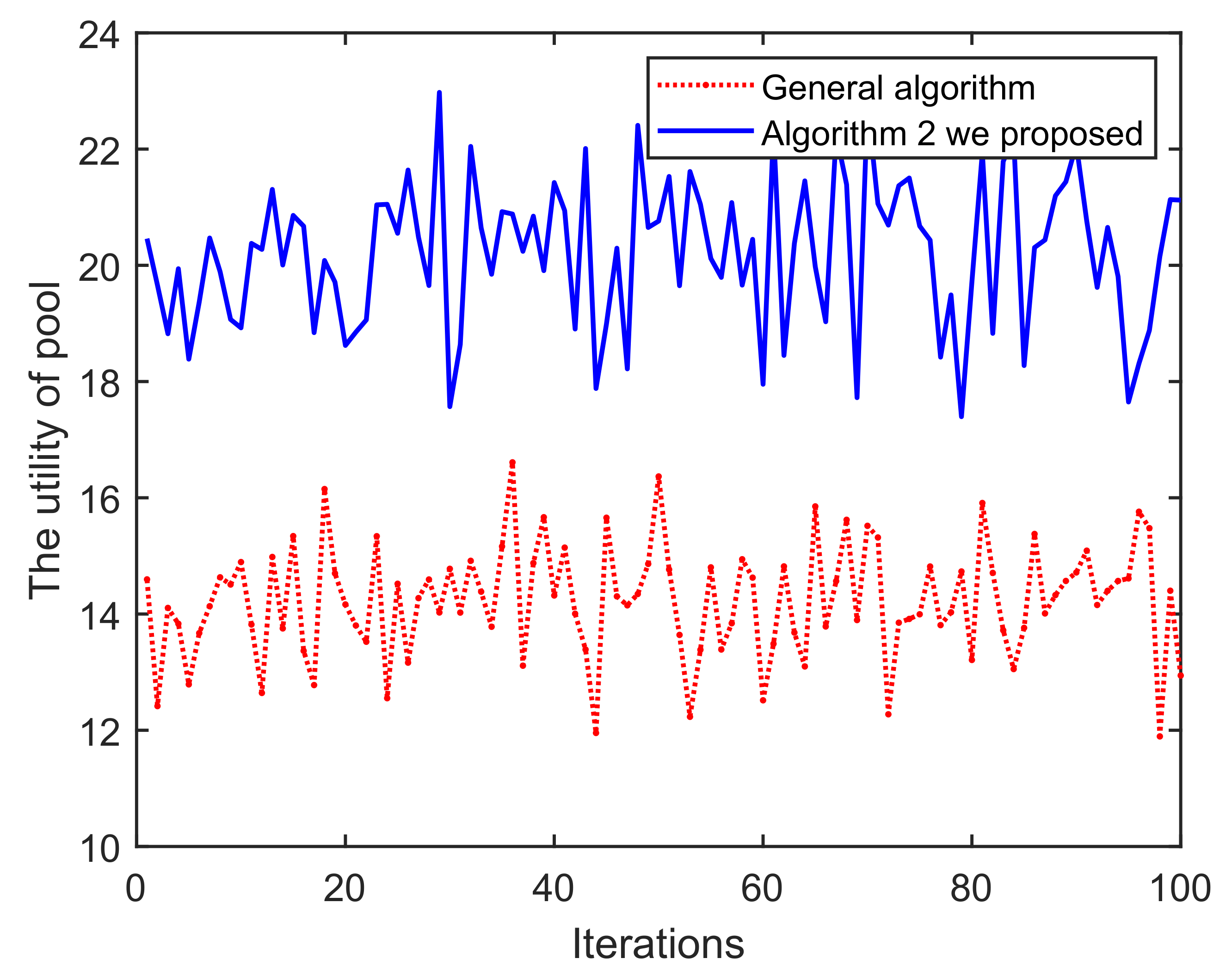
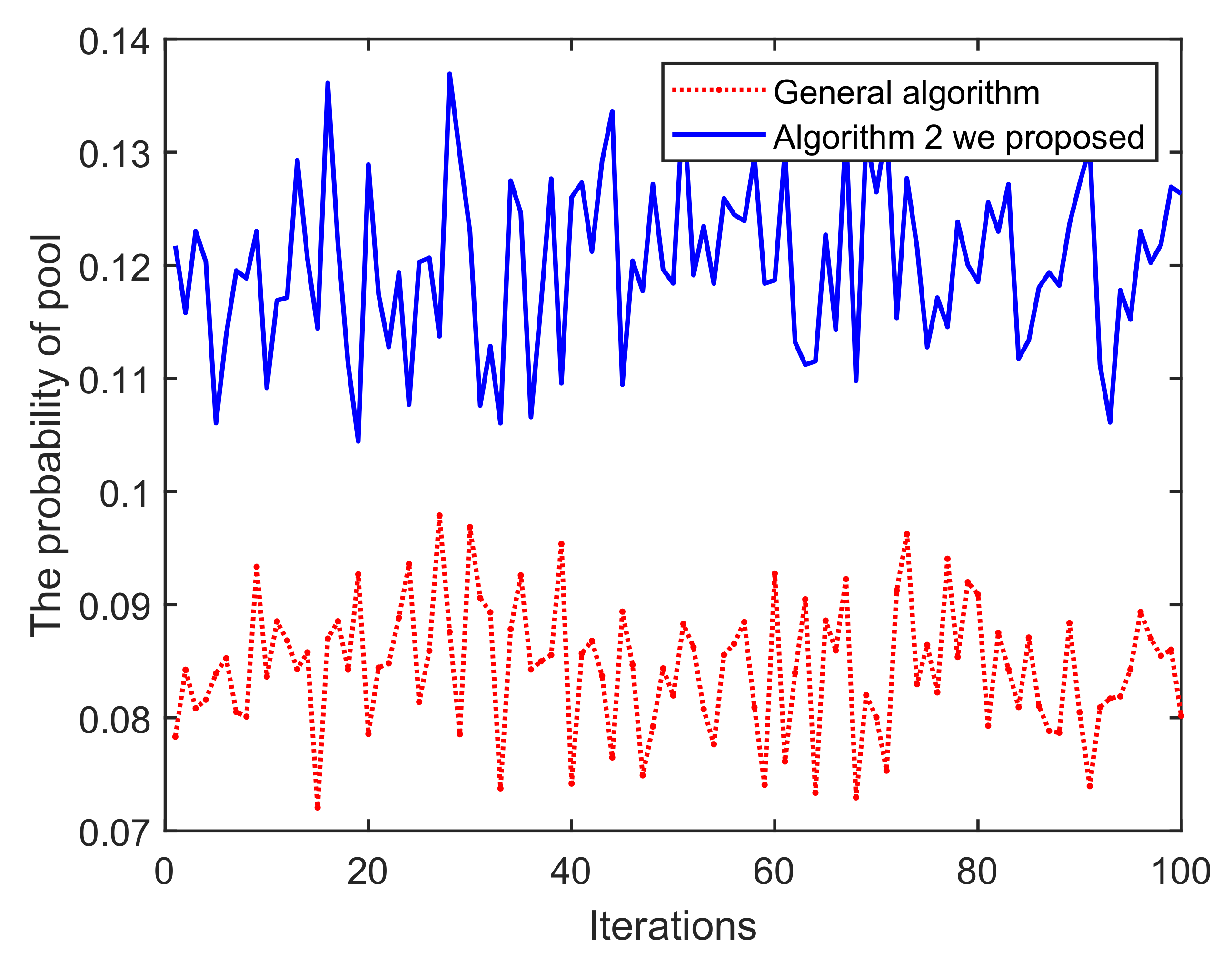
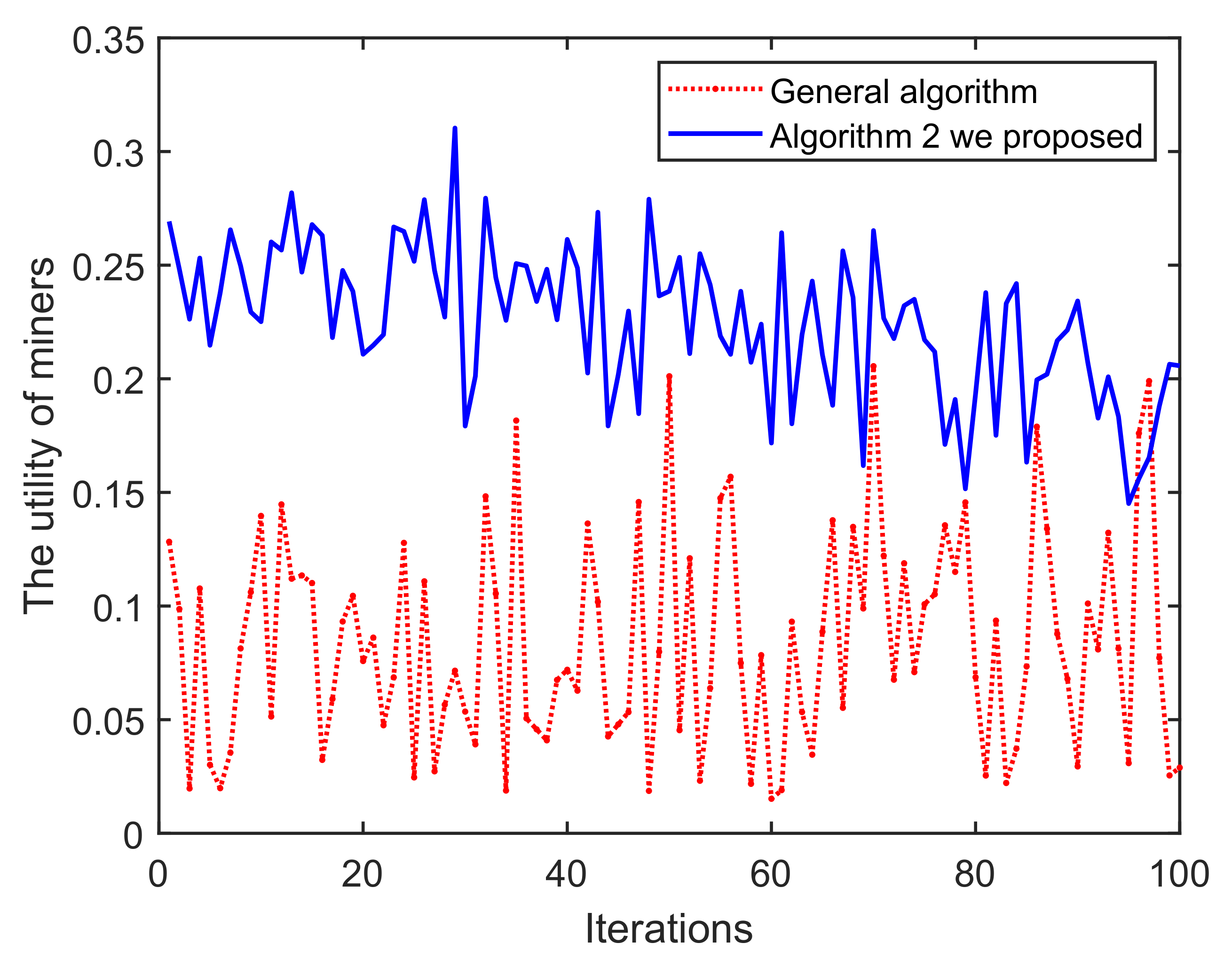
| Notations | Meanings |
|---|---|
| the set of all miners | |
| the set of all pools | |
| i | the i-th pool |
| j | the j-th miner |
| the miners except miner j | |
| the local reputation of miner j in the n-th round | |
| the local objective reputation of miner j | |
| the local subjective reputation of miner j | |
| the comprehensive reputation of miner j | |
| the crowdsourcing side-chain | |
| the remaining chains except | |
| the interactions in the crowdsourcing chain | |
| the minimum number of interactions | |
| the estimations of reputation obtained | |
| the normalized reputation evaluation of miner j | |
| the fixed reward | |
| the performance reward | |
| the participant reward | |
| the number of miners in the pool | |
| the number of honest miners in the pool | |
| the utility function of miner j in the n-th round | |
| the entry threshold of pool i | |
| the reputation fluctuation of miner j | |
| the survival times | |
| the probability of being dishonest for miner j | |
| the accumulated estimated reward of miner j | |
| d | the distance attribute of individual subtasks |
| the volume of budget segments | |
| the set of miners in pool i | |
| the distance threshold set by the requesters | |
| the number of continuous credibility | |
| the value of unit reputation for each segment | |
| the screening threshold of pool i | |
| the expected reputation of pool i |
Publisher’s Note: MDPI stays neutral with regard to jurisdictional claims in published maps and institutional affiliations. |
© 2022 by the authors. Licensee MDPI, Basel, Switzerland. This article is an open access article distributed under the terms and conditions of the Creative Commons Attribution (CC BY) license (https://creativecommons.org/licenses/by/4.0/).
Share and Cite
Guo, W.; Chang, Z.; Su, Y.; Guo, X.; Hämäläinen, T.; Li, J.; Li, Y. Reputation-Based Blockchain for Spatial Crowdsourcing in Vehicular Networks. Appl. Sci. 2022, 12, 11049. https://doi.org/10.3390/app122111049
Guo W, Chang Z, Su Y, Guo X, Hämäläinen T, Li J, Li Y. Reputation-Based Blockchain for Spatial Crowdsourcing in Vehicular Networks. Applied Sciences. 2022; 12(21):11049. https://doi.org/10.3390/app122111049
Chicago/Turabian StyleGuo, Wenlong, Zheng Chang, Yunfei Su, Xijuan Guo, Timo Hämäläinen, Jian Li, and Yuan Li. 2022. "Reputation-Based Blockchain for Spatial Crowdsourcing in Vehicular Networks" Applied Sciences 12, no. 21: 11049. https://doi.org/10.3390/app122111049
APA StyleGuo, W., Chang, Z., Su, Y., Guo, X., Hämäläinen, T., Li, J., & Li, Y. (2022). Reputation-Based Blockchain for Spatial Crowdsourcing in Vehicular Networks. Applied Sciences, 12(21), 11049. https://doi.org/10.3390/app122111049







